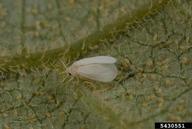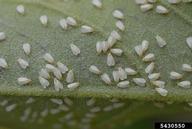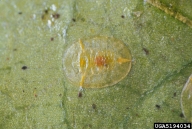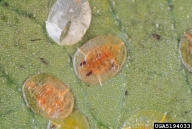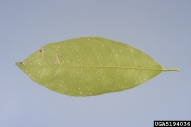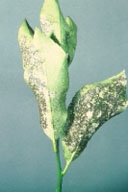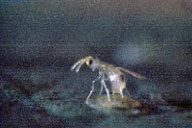Citrus whitefly
Dialeurodes citri (Ashmead), (Hemiptera: Aleyrodidae)
Orientation to pest
Citrus whitefly, Dialeurodes citri (Ashmead), is a polyphagous invasive whitefly of Asian origin that was once a major pest of citrus in the United States, as well as infesting a range of other plants. Like all whiteflies, this species has sessile nymphs that are affixed to plant surfaces, where they feed by removing plant sap, debilitating the host. Citrus whitefly secretes honeydew, leading to growth of sooty molds on infested plants.
Hosts commonly attacked
Citrus whitefly attacks many species, most of which are themselves introduced crops or ornamentals. These include citrus (Citrus), allamanda (Allamanda), banana shrub (Michelia figo [Lour.] Spreng), cape jasmine (Gardenia jasminoides J. Ellis), chinaberry (Melia azedarach L.), laurel cherry (Prunus laurocerasus L.), crape myrtle (Lagerstroemia spp.), Ficus macrophylla Desf. ex Pers., gardenia (Gardenia jasminoides J. Ellis), myrtle (Myrtus spp.), mock olive (Notelaea), and pear (Pyrus). Among the native North American plants attached are osage orange (Maclura pomifera [Raf.] Schneid.), water oak (Quercus nigra L.), persimmon (Diospyros), and green ash (Fraxinus pennsylvanica Marshall).
Distribution
In North America, citrus whitefly is found in the southeastern United States, from Florida west to Texas and north to Virginia, and also in California.
Images of citrus whitefly
| Figure 1. Adults of citrus whitefly, Dialeurodes citri | Figure 2. Nymph of citrus whitefly |
| Figure 3. Cast skin (top) of citrus whitefly | Figure 4. Leaf infested with citrus whitefly (white dots dispersed over leaf) | Figure 5. Sooty mold growing on honeydew produced by citrus whitefly | Figure 6. The aphelinid parasitoid Encarsia lahorensis, the key natural enemy of citrus whitefly |
Important biological control agents related to this pest species
This invasive whitefly has come under virtually complete biological control, at least on citrus, due the influence of the introduced parasitoid Encarsia lahorensis Howard.
Web links for information on citrus whitefly
- Featured Creature Fact Sheet | University of Florida and FDACS
- Article about Encarsia lahorensis | University of Florida IFAS Extension
Information on biology and life history of the parasitoid Encarsia lahorensis
Articles
- Bellows, T. S. and C. Meisenbacher. 2007. Field population biology of citrus whitefly, Dialeurodes citri (Ashmead) (Heteroptera: Aleyrodidae), on oranges in California. Population Ecology 49: 127-134.
